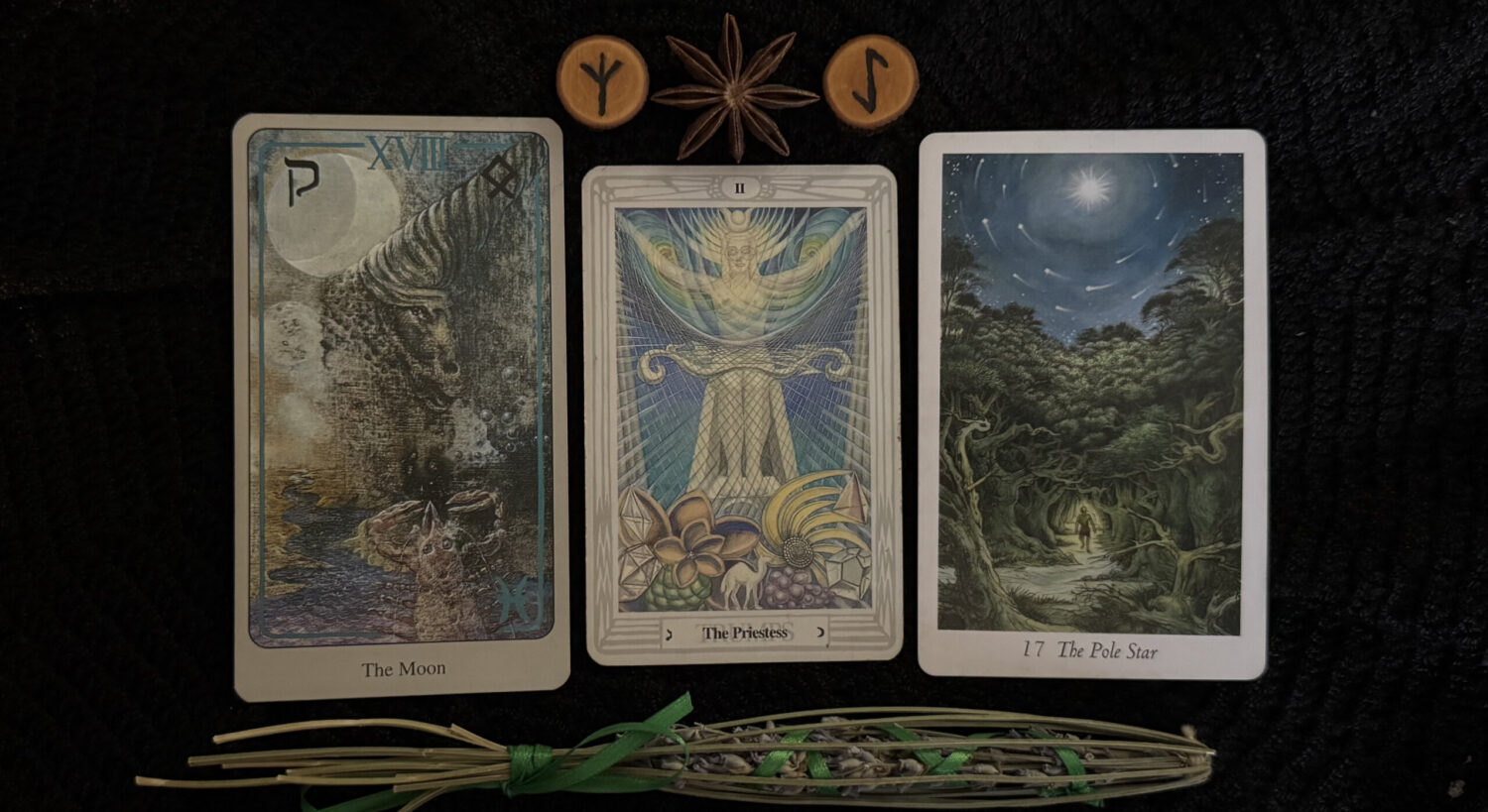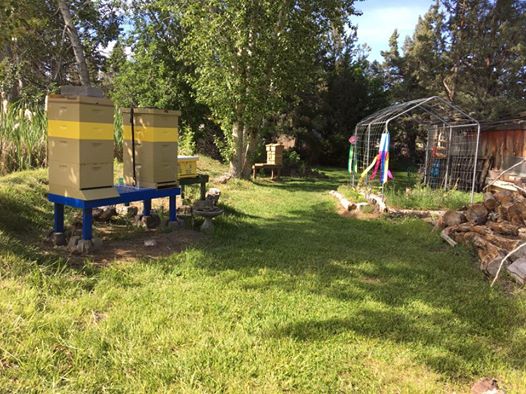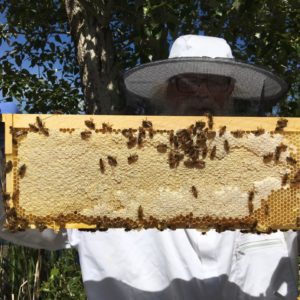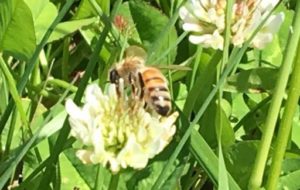Apparently after the winter we had a rockin’ bee colony. Both brood boxes from the original hive were full so to try to avoid swarming, a month ago we did what’s known as a walk-away split on the original hive. We took the top brood box 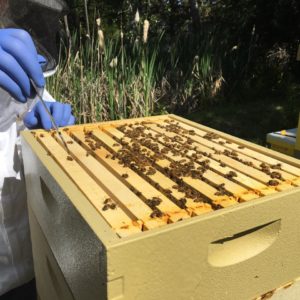 off of the second hive on the left, and moved it to the other side of the hive stand, placing it on top of an empty brood box. The idea was that the bees would hopefully build their brood nest downward. Most folks put the new boxes on top, but the Rose Hive and Warre methods favor inserting new boxes either below the others or in between and after researching, we like that idea.
off of the second hive on the left, and moved it to the other side of the hive stand, placing it on top of an empty brood box. The idea was that the bees would hopefully build their brood nest downward. Most folks put the new boxes on top, but the Rose Hive and Warre methods favor inserting new boxes either below the others or in between and after researching, we like that idea.
We had a medium honey super on top of the original hive that had quite a bit of honey in it so we pulled two or three frames of honey and added them to a medium honey super box that we put on top of the new split. That way, they’d have enough food to get them through the month-long re-queening process. Once a queen is either dead or gone, the bees will make a new queen. It was clear from the beginning that the queen was still in the original hive because all activity basically ceased in the new split. The nurse bees were still inside tending to the brood and it took some time before we saw bees flying in and out to bring back pollen and nectar.
Eventually, we began to see some activity and we calmed down a bit. Going in the hive today told the rest of the story. Although we didn’t see the queen, we did see eggs so clearly she’s there. The lower box had nothing really happening in it yet so we swapped the boxes, putting the box with the brood on the bottom. Because the medium honey super was nearly full of capped honey, we added another super below it, creating an empty area in between the lower brood box and the upper honey super. The bees should fill in both now. So not only are there two medium honey supers on the original hive, we have the same on the new hive. All in a month’s time. We couldn’t be happier.
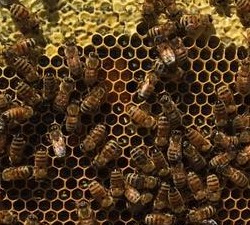 You can see in the picture on the right little white spots in most of the cells which are the eggs in various stages of development. The bees will eventually cap the brood and it will look brownish. The capped honey just above is cream or white in color. The picture below illustrates this difference nicely.
You can see in the picture on the right little white spots in most of the cells which are the eggs in various stages of development. The bees will eventually cap the brood and it will look brownish. The capped honey just above is cream or white in color. The picture below illustrates this difference nicely.
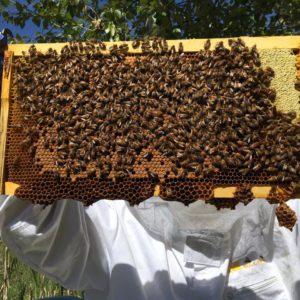 Typically the brood is somewhere in the center of the frame, with drone brood more toward the outside of the frame. That brood cell sticks up more than the others do and it’s easy to see. What you don’t want to see is a bunch of it because then you know that their queen isn’t functioning properly. There should always be more worker brood than drone brood. There will also be nectar, pollen, and honey on the frame as well. Some folks use a queen excluder between the brood boxes and the honey supers to keep the queen from going up in there and laying eggs. It’s a metal screen-like plate that’s big enough for the worker bees to pass through, but not the queen. We didn’t use one on either colony and it doesn’t look like she’s been up in there, so all honey!
Typically the brood is somewhere in the center of the frame, with drone brood more toward the outside of the frame. That brood cell sticks up more than the others do and it’s easy to see. What you don’t want to see is a bunch of it because then you know that their queen isn’t functioning properly. There should always be more worker brood than drone brood. There will also be nectar, pollen, and honey on the frame as well. Some folks use a queen excluder between the brood boxes and the honey supers to keep the queen from going up in there and laying eggs. It’s a metal screen-like plate that’s big enough for the worker bees to pass through, but not the queen. We didn’t use one on either colony and it doesn’t look like she’s been up in there, so all honey!
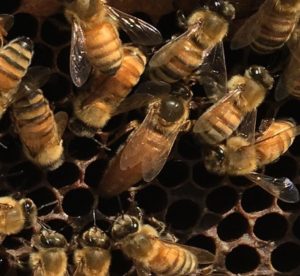 As I said, we didn’t see the queen in this hive, but we did see her in the new long hive we put in. This particular queen was crawling all over the place, very active. There was no way to miss her. And it’s the coolest thing ever to see the queen. We’ve never seen her in any of the hives other than the Warre’. And the only reason I saw her was because I purchased a package of bees for that new hive. In a package of bees, the queen comes in a cage and you have to release her into the hive and hope they accept her. Because they’ve had a few days with her already before they arrive at their final home, typically queen acceptance isn’t an issue. I pulled the plug out of the cage and inserted a mini marshmallow and then placed the cage in the bottom of the hive. The bees will eat the marshmallow and release their queen. She takes her maiden flight, flying up around 300 feet in the air where she’ll mate with a drone or a series of drones. Then she comes back to the hive and begins laying up to 2000 eggs per day. In her lifetime she may lay up to a million eggs.
As I said, we didn’t see the queen in this hive, but we did see her in the new long hive we put in. This particular queen was crawling all over the place, very active. There was no way to miss her. And it’s the coolest thing ever to see the queen. We’ve never seen her in any of the hives other than the Warre’. And the only reason I saw her was because I purchased a package of bees for that new hive. In a package of bees, the queen comes in a cage and you have to release her into the hive and hope they accept her. Because they’ve had a few days with her already before they arrive at their final home, typically queen acceptance isn’t an issue. I pulled the plug out of the cage and inserted a mini marshmallow and then placed the cage in the bottom of the hive. The bees will eat the marshmallow and release their queen. She takes her maiden flight, flying up around 300 feet in the air where she’ll mate with a drone or a series of drones. Then she comes back to the hive and begins laying up to 2000 eggs per day. In her lifetime she may lay up to a million eggs.
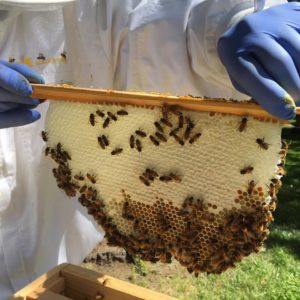 And my post wouldn’t be complete without a picture of a Warre’ foundation. We’ve been using foundationless frames in both the new long hive and the Warre. Typically, frames have plastic foundation with a hive cell pattern stamped in it. Foundationless comb can be tricky because it can break off and fall into the hive. The long hive has a different type of foundation than the Warre’ in that it’s a four-sided frame. The Warre’ foundations have only a top, no sides or a bottom. In the long hive, we’ve alternated foundation-type frames with foundationless. This reportedly keeps the comb straight on the foundationless frames which apparently matters when you harvest honey or need to pull frames for inspection.
And my post wouldn’t be complete without a picture of a Warre’ foundation. We’ve been using foundationless frames in both the new long hive and the Warre. Typically, frames have plastic foundation with a hive cell pattern stamped in it. Foundationless comb can be tricky because it can break off and fall into the hive. The long hive has a different type of foundation than the Warre’ in that it’s a four-sided frame. The Warre’ foundations have only a top, no sides or a bottom. In the long hive, we’ve alternated foundation-type frames with foundationless. This reportedly keeps the comb straight on the foundationless frames which apparently matters when you harvest honey or need to pull frames for inspection.
So that’s what we did in the long hive. But in the Warre’, alternating frames wasn’t possible, so we won’t be pulling frames much. The boxes are much smaller than the Langstroth style long hive, so we can simply lift the boxes up to see what they’re doing from beneath. With a Warre’ hive, boxes are added underneath and the bees build downward. Eventually, the initial brood box will be converted by the bees into a honey super and we’ll harvest the comb from there. But not this year. And maybe not the next. The bees get all honey until there’s too much. Then and only then do we take any honey.
But I can tell you in all honesty that there’s nothing like bees. And becoming a beekeeper will be the best thing you will ever do with your life. Truly.
~Blessed are the Bees for they will save us all!
If anyone intends to either quote something I've written, or intends to post any part of my work, including my videos, on any other site, please ask permission before doing so. Any reposting of my work without permission can be considered as copyright infringement, so please ask. And if I give permission, you MUST clearly reference my name as author and my website. No exceptions. The words an author writes are sacred. Unapproved use is not.
Thank you... Jan Erickson
